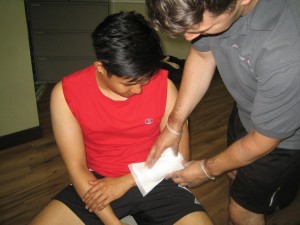Atopic dermatitis is considered as a common form of eczema which is a skin condition that primarily affects children but can occur among adults. The symptoms of this skin condition include swelling, rashes, severe itchiness, severe redness of the skin and weeping or crusted cracks in the skin. Take note that the symptoms typically lessen with age and can disappear once adulthood is reached. On the other hand, most cases would require appropriate first aid care and treatment.
Treatment measures for atopic dermatitis
You have to take into consideration the following treatment options for atopic dermatitis.
Care at home
Always bear in mind that preventive care at home is considered as a vital part of the treatment process for this skin condition. Individuals who suffer from atopic dermatitis should be encouraged to bathe no more than once in a day and use mild soap.
Once the skin becomes dry, it will only aggravate the symptoms, thus a moisturizer must be applied right after a bath and all throughout the day to prevent the skin from drying up. Thick emollients or creams that help retain the moisture without absorbing into the skin are good options. The individual must also wear loose fitting clothes made out of cotton to help prevent further irritation.

Administration of antihistamines
Antihistamines are given to minimize the itchiness and redness linked with atopic dermatitis. Since most antihistamines cause drowsiness, they are often prescribed before bedtime to help with sleep and prevent scratching the affected skin at night.
Applying topical corticosteroids
Corticosteroids are used to minimize the inflammation and itchiness. Take note that corticosteroids are prescribed and they are not recommended for more than a few weeks at a time but can be prescribed for future flare-ups of the skin condition. The side effects if corticosteroids are used include slowed growth, cataracts and increased risk for infection.
Light therapy
Light therapy is an outpatient procedure and involves the exposure of certain parts of the skin where atopic dermatitis formed to ultraviolet light. The treatment option is typically performed two to three times in a week. It can take a number of months of treatment in order to completely clear up the symptoms. The therapy can also be used together with topical treatments in order to speed up the healing process.
Antibiotics
Antibiotics are prescribed for the recurring cracks on the skin that can eventually lead to bacterial infections. Individuals who take immune system suppressors face a higher risk for secondary infection. If a fungal infection is present, an anti-fungal cream will also be prescribed.
Calcineurin inhibitors
Calcineurin inhibitors work by suppressing the immune system in order to minimize and prevent the itchiness and redness linked with atopic dermatitis. The medication can come in the form of a topical cream or ointment and can be used when corticosteroid treatments are not effective. The side effects of these medications include headaches, acne and momentary burning sensation.
